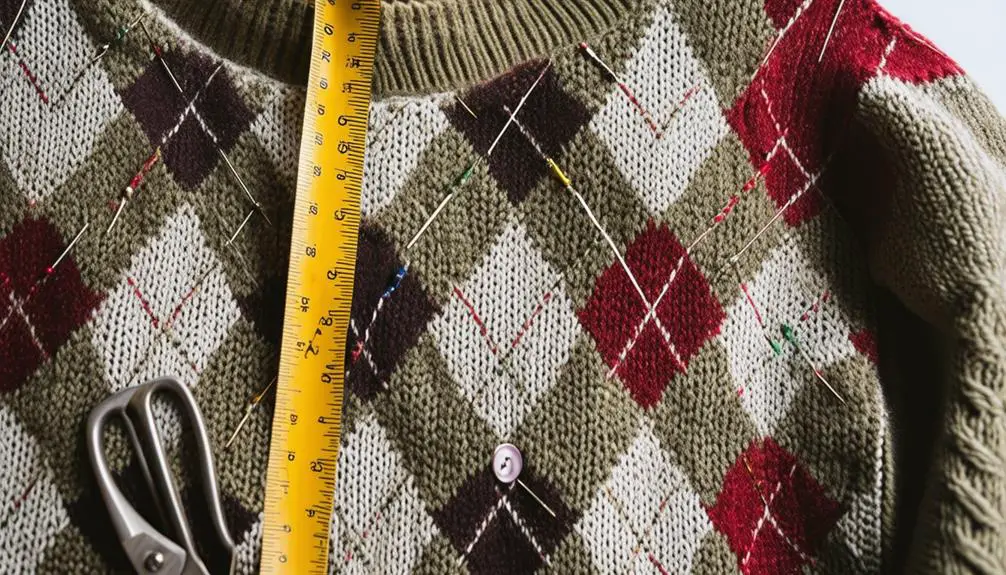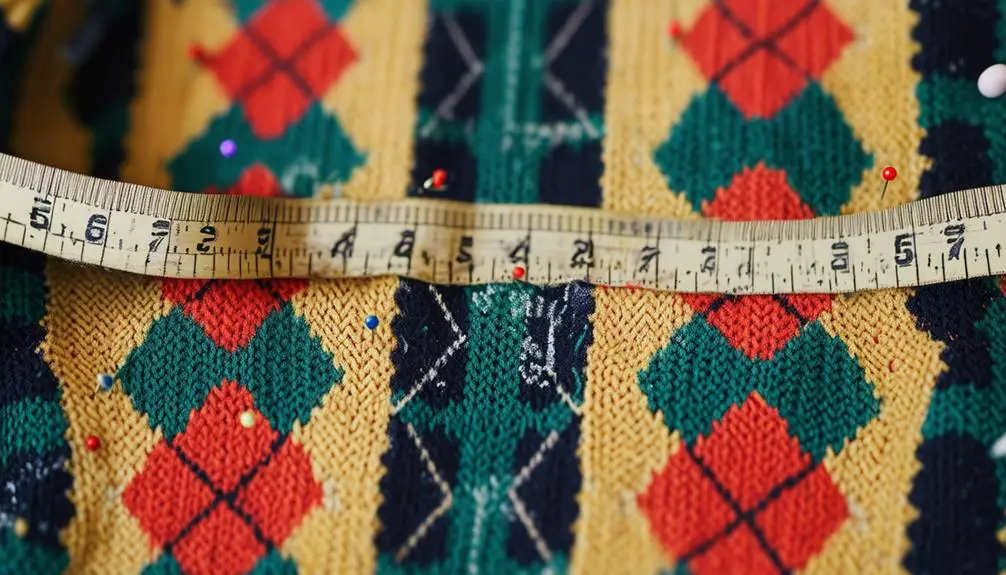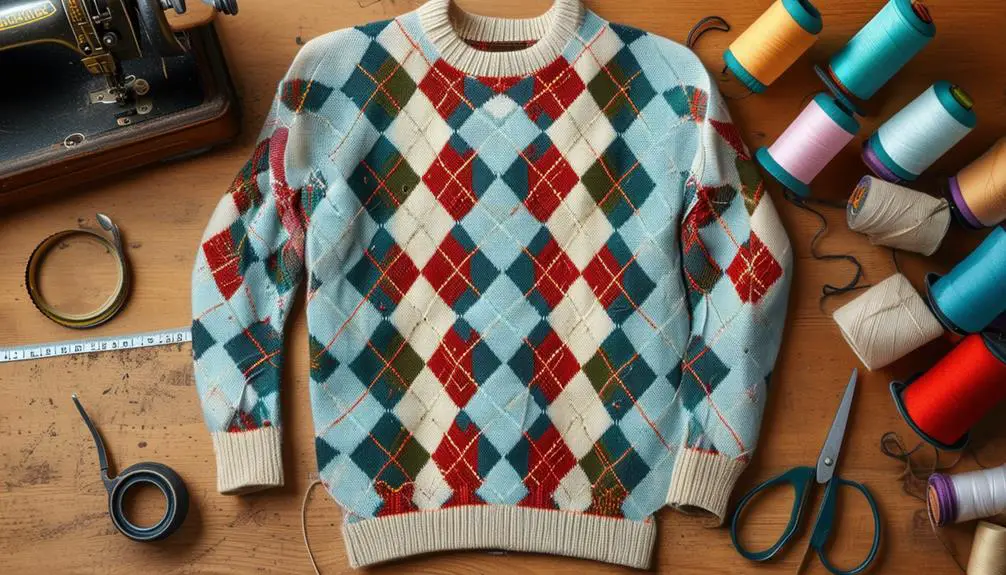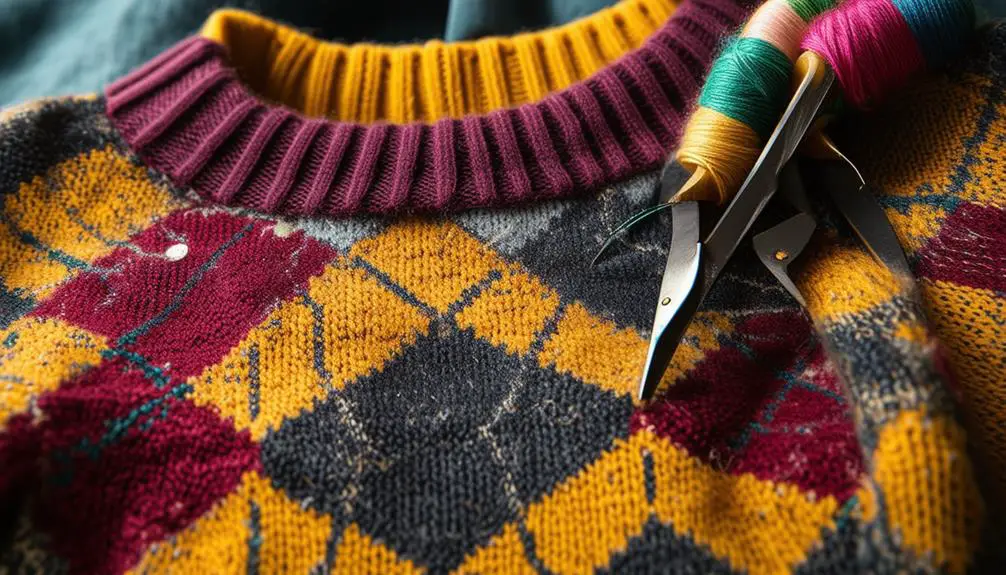To tailor a vintage argyle sweater, start by trying it on to assess the fit—look for excess fabric around the shoulders, chest, and waist. Use a measuring tape to mark any adjustments with fabric chalk, ensuring symmetry. Carefully unpick the seams with a seam ripper and pin the sweater to its new fit. When sewing, opt for a stretch stitch to maintain elasticity, especially when adjusting sleeves or the hem. Don't forget to wash it in cold water and lay it flat to dry, preserving its unique charm. There's a wealth of tips that could further enhance your sweater transformation.
Assessing the Fit

Evaluating the fit of your vintage argyle sweater is essential to achieving that perfect look. Start by trying it on and checking for areas that feel too loose or tight. Focus on the shoulders, chest, and waist to guarantee you're getting the right fit.
You'll want to measure the sweater's length from the shoulder seam to the hem; a flattering length usually falls around the hip for that relaxed vibe. Vintage clothing often embodies unique characteristics and craftsmanship, which can greatly impact the overall fit and style of the garment. Understanding the vintage clothing trends by era can also inform your tailoring choices.
Next, assess the sleeve length by extending your arms. The cuffs should sit comfortably at your wrists, neither too short nor too long. If you notice excess fabric around the sides and back, it's a sign you might need to take in the seams for a more tailored silhouette.
Think about your desired style—do you want a fitted look or something more relaxed? This choice will directly influence your tailoring decisions.
Tools Needed for Tailoring
When tailoring your vintage argyle sweater, having the right tools on hand can make all the difference in achieving a polished look. Start with a reliable sewing machine; it's essential for making precise alterations that look professional. Without it, you might struggle to achieve that clean finish you desire.
Next, grab a measuring tape to take accurate measurements. This tool is important for determining how much fabric you'll need to remove or adjust, ensuring a perfect fit.
You'll also want a good pair of scissors or a rotary cutter for cutting the fabric. Clean edges are critical for a neat appearance.
Don't forget about fabric pins or clips! They'll hold your sweater in place during the tailoring process, preventing any unwanted shifting while you sew.
Finally, a seam ripper is your best friend for removing any existing seams or stitches that need alteration. It's a simple yet powerful tool that can save you time and frustration.
With these tools in your arsenal, you'll be well-equipped to transform your vintage argyle sweater into the perfect piece that fits you flawlessly.
Marking Adjustments

As you prepare to tailor your vintage argyle sweater, marking adjustments becomes an essential step in achieving that perfect fit. Start by trying on the sweater to pinpoint specific areas needing alteration—like the sleeves, hem, or body width.
Once you identify these spots, grab some fabric chalk or a fabric marker. Carefully mark the desired adjustments, ensuring that you measure accurately for a symmetrical look on both sides, which is crucial for preserving that classic argyle pattern.
When it comes to marking the hem, keep the original seam allowance in mind to maintain the sweater's aesthetic and avoid excessive shortening. For sleeve adjustments, mark your desired length while ensuring the armhole remains comfortable and doesn't restrict your movement.
Remember, vintage fabrics can behave differently than modern materials, so always double-check your measurements before cutting or sewing. This meticulous approach to marking adjustments not only enhances the fit but also honors the unique charm of the vintage argyle sweater.
Taking these steps will set you up for a successful tailoring process, ensuring your sweater looks stylish and feels just right.
Unpicking Seams
Starting the process of unpicking seams on your vintage argyle sweater can feel intimidating, but with the right tools and approach, it becomes a manageable task. Begin by grabbing a seam ripper; it's specifically designed to cut through stitches without harming the fabric. Carefully work the seam ripper under the stitches, gently pulling them apart to avoid tearing the delicate wool or cashmere of your neck sweater.
Make sure you're in a well-lit area to clearly see the stitches and preserve the integrity of the argyle pattern. Taking your time is essential—rushing can lead to mistakes or snags that could ruin your beloved sweater.
To keep your workspace tidy, consider having a lint roller or small vacuum handy to clean up any loose threads.
Here's a quick reference table to guide you through the unpicking process:
| Step | Description |
|---|---|
| Gather Tools | Use a seam ripper, scissors, lint roller |
| Position Sweater | Lay it flat in a well-lit area |
| Unpick Carefully | Work slowly, ensuring you don't tear fabric |
| Clean Up | Remove loose threads to maintain order |
With patience and care, you'll master this skill!
Sewing Techniques

Tailoring a vintage argyle sweater requires precision and an understanding of the unique properties of knit fabrics. To avoid fraying during alterations, you'll want to use a serger or a zigzag stitch. Vintage clothing often features distinctive patterns and craftsmanship, making it vital to handle these pieces with care, especially when it comes to identifying vintage styles.
Start by carefully unpicking the side seams. Once you've done that, pin the sweater to your desired fit, guaranteeing both sides are symmetrical before you sew.
For length adjustments, measure from the hem to your preferred length, mark a straight line, and cut. Use a double-fold technique to sew a new hem, which will help maintain a clean edge. If you're adjusting the neckline, consider finishing with bias tape; it gives a polished look while allowing the fabric to maintain its stretch.
It's essential to test any sewing techniques on a scrap piece of fabric first. This way, you can see how the stitches interact with the knit without risking damage to your vintage piece.
Adjusting Sleeves and Body
When you're ready to adjust the sleeves and body of your vintage argyle sweater, it's all about achieving that perfect fit. Here's how you can tackle these adjustments effectively:
- Shorten the Sleeves: Measure the desired sleeve length and unpick the cuff seams. Trim the excess fabric, then reattach the cuffs using a sewing machine or hand stitching. This keeps your look polished.
- Take in the Body: Determine how much fabric you need to remove by measuring the excess width at the sides. Trace a new seam line from the underarm down to the hem and sew along this line. This gives your sweater a more flattering silhouette.
- Check for Comfort: After making adjustments, try the sweater on to verify it fits comfortably. Vintage materials can behave differently than modern fabrics, so it's essential to avoid over-altering.
Using a sewing machine with a stretch stitch or a serger helps maintain elasticity, preventing tearing.
If your sweater feels oversized, consider adding darts at the back for a tailored look. Embrace these adjustments, and you'll have a vintage piece that feels custom-made!
Neckline Modifications

Transforming the neckline of your vintage argyle sweater can breathe new life into its style, allowing you to express your individuality. Start by carefully unpicking the existing seam with a seam ripper, making sure you don't damage the fabric.
If you're aiming for a more relaxed look, consider converting a crew neck into a wider boat neck. Cut along your desired line and finish the edge with bias tape or a serger for a polished finish.
On the other hand, if you want a cozy turtleneck effect, lower the neckline and add a knitted or fabric extension that can be folded over for extra warmth. Before you cut, measure accurately to verify the new neckline suits your style, accounting for seam allowances as needed.
Once you've made your modifications, it's crucial to maintain the sweater's integrity. Use a sewing machine with a stretch stitch or opt for hand-stitching to reinforce the new neckline.
This attention to detail won't only enhance the look but also guarantee your vintage piece remains durable and fashionable for years to come.
Maintaining Stretch
Maintaining the stretch of your vintage argyle sweater is essential for keeping it looking and feeling great over time.
When you care for your sweater properly, you'll guarantee it retains its shape and elasticity. Here are a few key tips to help you out:
- Wash with Care: Always use cold water and a gentle detergent. Hot water can shrink the fibers, while bleach can weaken them. Preserve that beautiful stretch!
- Dry Flat: After washing, lay your sweater flat to dry. Hanging it can stretch out the shoulders and body, leaving you with an awkward fit. A flat surface allows the fabric to maintain its original shape.
- Store Wisely: When it's time to put your sweater away, fold it instead of hanging. This prevents distortion and helps keep that coveted stretch intact.
Final Washing Tips

After ensuring your vintage argyle sweater retains its stretch, it's time to focus on how to wash it properly to keep it in pristine condition. Start by washing your sweater in cold water; this prevents shrinking and helps preserve those vibrant colors and patterns. You can either use a gentle cycle on your washing machine or opt for hand washing, especially if your sweater is made from delicate materials like cashmere or wool.
Avoid bleach and harsh detergents, as they can damage the fibers, leading to fading and weakening over time. After washing, never hang your sweater to dry; instead, lay it flat. Hanging can stretch the fabric, particularly in vintage knitwear that may already be prone to distortion.
Here's a quick reference table for your washing routine:
| Tip | Action |
|---|---|
| Water Temperature | Always use cold water |
| Washing Method | Gentle cycle or hand wash |
| Detergent | Avoid bleach and harsh chemicals |
| Drying Method | Lay flat to dry |
Regularly inspect your sweater for signs of wear and tear, allowing for timely repairs that can prolong its life and maintain its vintage appeal.
Styling Your Tailored Sweater
A tailored vintage argyle sweater is a versatile piece that can effortlessly elevate your wardrobe. With its unique patterns and rich history, it offers countless styling possibilities. Here are some great ways to wear it:
- Casual Chic: Pair your sweater with high-waisted jeans. This combination accentuates your waist and adds structure to your silhouette, creating a relaxed yet stylish look.
- Sophisticated Layers: Layer your sweater over a collared shirt or turtleneck. This not only adds sophistication but also makes it suitable for both casual outings and office settings.
- Stylish Accessories: Don't forget to accessorize! A statement necklace or scarf can add a pop of color, elevating the overall aesthetic of your tailored sweater.
For a changeable outfit, combine the sweater with tailored shorts or a skirt, perfect for spring and autumn.
Finish your look with classic footwear like loafers or ankle boots to maintain comfort while complementing the timeless appeal of your vintage argyle.
With these styling tips, you can truly showcase the charm of your tailored sweater in any setting.
Frequently Asked Questions
How to Style an Argyle Sweater?
You can style an argyle sweater effortlessly by pairing it with high-waisted jeans or layering it over a collared shirt. Add ankle boots or a pleated skirt, and don't forget eye-catching accessories to complete your look!
Is It Possible to Tailor a Sweater?
Yes, you can definitely tailor a sweater! Adjusting its fit enhances comfort and style. Just remember to use proper techniques and consider consulting an experienced tailor to maintain the fabric's integrity and overall design.
Is Argyle Back in Style?
Absolutely, argyle's back in style! You'll see it everywhere, from TikTok trends to high-fashion runways. Embrace the vintage vibe, and mix it into your wardrobe for a fresh, stylish twist that's sure to impress.
When Were Argyle Sweaters Popular?
Argyle sweaters saw their peak in the 1920s, then exploded in popularity during the 1950s and 1980s. Today, you can appreciate their timeless charm, as they effortlessly blend vintage heritage with modern fashion trends.





I don’t think the title of your article matches the content lol. Just kidding, mainly because I had some doubts after reading the article. Gii thiu binance
This sounds like someone took an AI article on ‘tailoring’ a shirt and just substituted ‘sweater’. As a vintage dealer and experienced sewist, I can tell you that trying to perform any of these actions on a sweater is likely to ruin it – even high end sweaters that are made in pieces can’t just be pinned, cut and sewn back together unless you have a lot of experience with knitwear and/or specialized sewing machines. I’d advise buying vintage clothing, particularly knitwear, that fits the way you want it to – it’s often not too difficult to shorten sleeves or hems on sewn garments, but ‘altering’ sweaters is not something that’s likely to work out the way you want.